
 |
Charlotte Stonestreet
Managing Editor |
| Home> | AUTOMATION | >Vision Systems | >Machine vision cameras capture Mars landing |
ARTICLE
Machine vision cameras capture Mars landing
30 April 2021
On February 18th, NASA successfully landed the Perseverance Rover on Mars. This isn’t the first Mars mission, but it was the first time that the entry, descent, and landing of a spacecraft was filmed and broadcast live for the public to watch and virtually participate in.
Six FLIR machine vision cameras captured the event from multiple angles, documenting all stages of the thrilling touchdown. While only a few minutes long, the footage has already helped engineers evaluate how well their work performed in space, and inspired millions of viewers around the world.
Watch the official video released by NASA of the descent and touchdown:
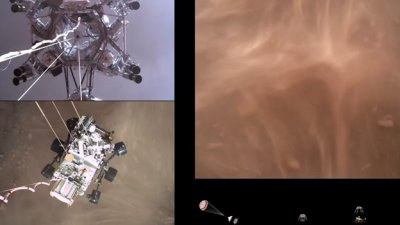
The Entry, Descent, and Landing (EDL) of the rover may only be a few minutes long, but there’s a lot going on in those few minutes. Here’s a breakdown of what you’re seeing and from what angle.
After entering the Martian atmosphere, the parachute deploys about 7 miles (11 kilometers) from the surface. Just before this point, three up-looking cameras began recording, capturing footage of the supersonic deployment of the most massive parachute ever sent to space:
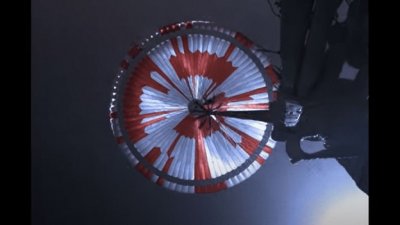
Five miles off the ground, the heat shield (used to protect the rover during entry into the Martian atmosphere) drops off and exposes the rover down-look camera, showing some of the rover’s intense ride to Mars’ Jezero Crater:
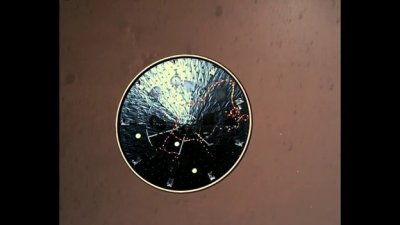

Five miles off the ground, the heat shield (used to protect the rover during entry into the Martian atmosphere) drops off and exposes the rover down-look camera, showing some of the rover’s intense ride to Mars’ Jezero Crater:

Then the rover drops away from the back shell (and parachute). From there its descent is managed by a rocket-powered descent stage called the “SkyCrane.” Here’s a view of the rover captured by a down-looking camera on the SkyCrane:
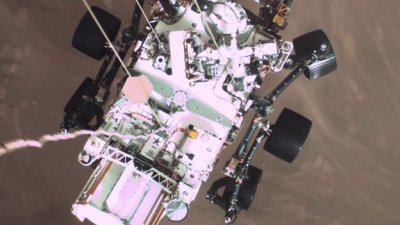
Then it’s touchdown! Here’s a view (from a camera on the rover) of the SkyCrane being swept away as the rover touches down on the surface of Mars to begin its mission:
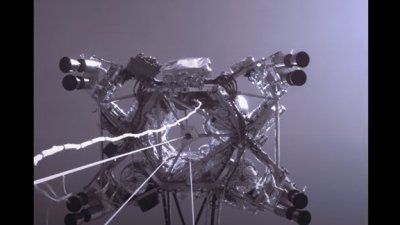
The cameras that captured this footage are FLIR RGB machine vision cameras, and include five 1.3-megapixel cameras and one 3.1-megapixel USB camera. “Our cameras are designed for operation on Earth, and not built to operate in outer space,” said Sadiq Panjwani, VP of the Integrated Imaging Solutions (IIS) division at FLIR. “So we were quite thrilled that NASA put them to the test.”
NASA began contacting FLIR in 2015 to investigate suitable cameras for the EDL (Entry, Descent Landing) system. Engineers were looking for commercial off the shelf (COTS) hardware with an emphasis on low cost and ease of system integration.
This is the first time that FLIR machine vision cameras have been subjected to the extreme temperatures or high gravity forces experienced during the Mars landing. Everyone involved in engineering and manufacture of cameras at FLIR is thrilled about this testament to their durability and performance. And of course, ecstatic to say that their work has made it to Mars!
MORE FROM THIS COMPANY
- Thermal imaging clamp meter
- High speed industrial automation
- Digital multimeter
- Dew point meter for compressed air systems
- Low-cost thermal imaging camera for smartphones & tablets
- Preventing unscheduled downtime
- Intelligent choice for real-time application
- Entry-Point advanced thermal imaging camera
- FLIR completes strategic investment in DroneBase
- Locates smaller compressed air leaks
RELATED ARTICLES
- Turnkey hovercraft drivetrain guarding
- More Ways of Identifying Objects
- HD Machine Vision
- Bespoke Vision Sensor Packages
- B&R NEW WEBSITE
- View Images & Overlay Graphics
- Get A Lock On 3D Measurement
- Entry-level vision system
- Multipix will launch the NEW Datalogic MATRIX 450
- Process, print and packaging inspection systems on show
OTHER ARTICLES IN THIS SECTION


















